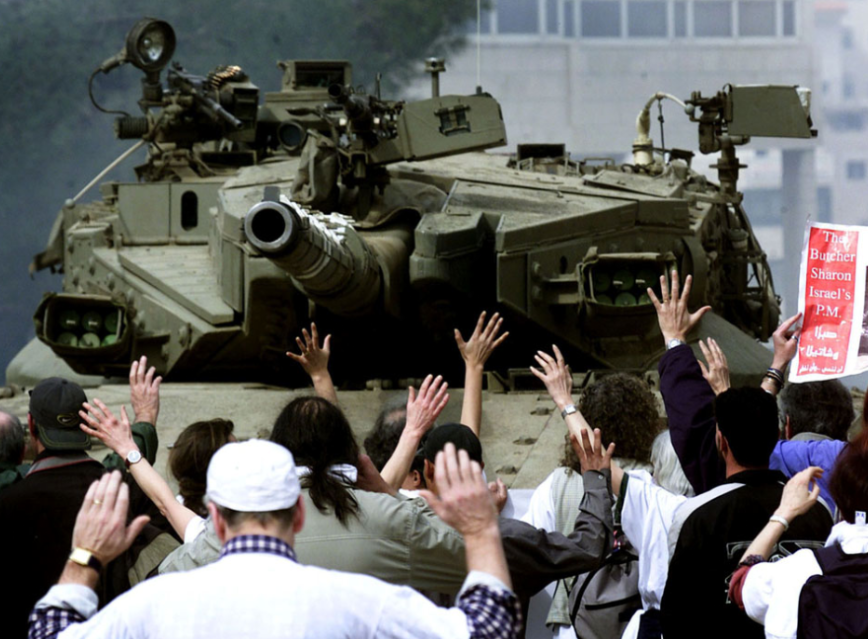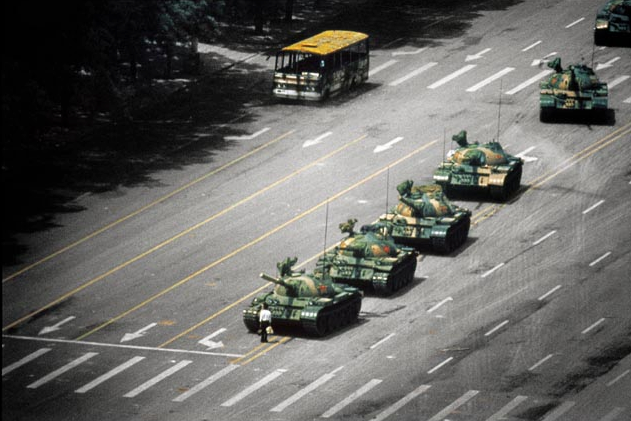The scene here is Ramallah, February 2002. The tank is Israeli and the people blocking its path with their hands raised as if under arrest are Palestinians. The photograph is part of a NYT slideshow featuring the work of the recently wheel chair bound Palestinian photojournalist Osama Silwadi, who continues to photograph Palestinian life, albeit from a “new vantage.” His work, both prior to being crippled in 2006 by two bullets that shattered his spine and subsequently, is a testament to the power of photography to document the ever present tension between the tragedy and soulfulness of human life. The image that caught my attention, however, was the one above, which features the visual trope of the tank as the symbol of the totalitarian state.
Developed by the British during WWI, the tactical and strategic capacity of the tank was revolutionized by the Germans during WW II, where it became a central element of the military strategy of “lighting warfare” known as the blitzkrieg. Known for the combination of offensive and defensive mobility, as well as its strong fire power, the tank was understood to be a formidable, if not altogether unassailable, weapon of modern warfare, and its technological development was a key feature of the Cold War “arms race.” More important to the purpose here, it was during the Cold War that the “tank” took on symbolic significance as something more than just a military weapon as it was regularly featured as an emblem of state power, typically by eastern bloc nations.
The symbolic connection of the tank to totalitarian regimes in particular was marked visually not only by its size, but more importantly, by its panoptic quality: thoroughly enclosed and sealed off from any outside observation or unwanted intrusion, the arbiters of state authority residing inside of the tank are nevertheless in position to monitor and control the outside world with near invincible power. But, of course, as powerful as they are, tanks are not invincible, just as totalitarianism is not unconquerable, and so the visual trope of the tank has developed across time to call attention to the power and capacity of unarmed (and armor less) humans to challenge and even overcome totalitarian regimes, generally in the name of human rights. The first such image to make the point might well be the photograph of revolutionaries standing atop a Soviet tank in Budapest during the Hungarian Uprising of 1956, though no doubt the most famous of such images would have to be of the lone individual standing down a row of tanks in Tiananmen Square.
Silwadi’s photograph draws upon the visual trope of the tank as the signifier of totalitarianism in powerful ways, but it does it in a manner that make it importantly distinct from the famous Tiananmen Square image. Shot at a low angle, as if from the perspective of the humans beings being assaulted, Silwadi’s tank looms large, dominating both the frame and the scene it purports to represent. No faces are evident, as the tank functions as the mask of the totalitarian state, and those being imposed upon have directed their gaze away from the camera to the immediate power that challenges and confronts them. At the same time, the gun barrel is directed at the viewer in the manner of a visual demand that encourages identification with the crowd and in opposition to the authority of the tank.
By contrast, the Tiananmen Square photograph is shot from on high and at a distance, invoking an optical consciousness that James C. Scott dubs “seeing like a state.” The viewer is here insinuated as a distant observer of the scene and not an immediate participant in the drama that is unfolding. But more, note that it is a lone individual who challenges the authority of the state, and not a collectivity, and so in a sense the viewer of the image is encouraged to identify with the scene as a liberal individual. As we have argued elsewhere and extensively, the Tiananmen Square photograph activates a cultural modernism that displaces democratic forms of political display and opposition (remember that the protests in Tiananmen Square included thousands of students and nearly a million protesters in all who had organized in various groups) and plays to western conceptions of individualism and apolitical social organization. Thus, while the photograph of a man challenging a tank can function as a progressive celebration of human rights, it also risks limiting the political imagination to narrowly liberal versions of a global society.
Silwadi’s photograph confronts this logic by reinterpreting the visual trope of the totalitarian tank and reminding us that what is at stake here is not just a challenge to universal and liberalized human rights that can be observed and contested from afar, but that indeed we are all implicated in and by the presence of totalitarianism wherever it occurs … and not just as individuals but as citizens in a democratized, global public culture.
Photo Credits: Osama Silwadi/Apollo Images; Stuart Franklin/Magnum Photos


Silwadi’s photograph of protesters in Ramallah allows the viewer to enter the Tiananmen Square photograph at the precise perspective of the lone man who confronts the tanks. His isolation and static posture become even more poignant when compared with the crowd of Palestinians–hands upraised–who confront the single, totalitarian icon of the Israeli tank. The tension of the Tiananmen Square agent stands in a starkly modernistic public space, a space presumably emptied because of the tanks. (Just as the Ramallah space is presumably filled because of the tank.) The plurality of the Tiananmen tanks and the Chinese protester’s isolation ignores the multitudes who had filled the square so recently, outnumbering the tanks. That multitude is more representative of the protests than the anguished isolation of the protester in the famous photograph. A view of rebellious crowds from a high angle of surveillance would not have served the Western ideal of individualism, but the stark singularity of the man in the square satisfied that ideal. The Silwadi photograph, in contrast, allows our participation as agents, not as detached spectators. The crowded visual space and the low angle allow us to view the tank head on, en masse; the photograph allows us to feel included in a group action, a democratic spirit at odds with the distant liberalism of the Tiananmen Square photo. Do we want to participate, at eye-level to the barrel of a tank, or would we prefer to observe such protest actions at a distance? The photographers’ perspectives allows the viewer to choose a level of “participation”–but the culture of photojournalism doesn’t provide many options, as evidenced by these two photos. We are either trapped in a crowd, confronting the “visual trope of the totalitarian tank”, or detached and “seeing like a state”. Thus, photojournalists, working from their cultural viewpoints (and photo editors, selecting the photos) provide limited “access” to events. They reiterate a limited number of visual tropes of protest photojournalism. Silwadi shoots as a participant-observer, “from a new vantage” as a wheelchair bound photojournalist. Franklin, the Tiananmen Square photojournalist, shot his iconic image in the role of an observer, with very little participation. Yet, the tension in both photographs is: Will the tanks use their weaponry on the protesters (or protester)? It is a false tension, a construction, a visual challenge created by the photographers. Just as the tanks serve as images of force, and the protesters serve as images of resistance, there are rarely photographs of tanks shooting into crowds of protesters (or at lone protesters). This type of confrontation–between state force and peaceful protest, is characteristic of civil rights photography. Then, showing people attacked by dogs and fire hoses was acceptable photojournalism. Those images allowed viewers to take a side, and photojournalism served the civil rights cause. A tank, as a symbol of totalitarianism, also allows viewers to take sides. The tank must not act, however, but must be defeated by peaceful unarmed protest. The Tiananmen Square photograph highlighted, then diminished the tank as a symbol of state power. The Silwadi photograph illustrates that protesters know that tanks are symbols of state force that the state may not actually use. Now we can confront the tanks eye-to-eye, not alone, but as “citizens”–a group force. When we confront the tank eye-to-eye, as in Silwadi’s photo, the tank loses power as a “visual trope of totalitarianism.”
Brenda: Excellent read. And I am compelled by most of it. Two things, though. First, and it is probably because I wasn’t clear, but the Silwadi photo, while shot as a participant-observer is NOT shot from a wheelchair. This photo was taken in 2002, he didn’t suffer the injury that put him in a wheelchair until 2006. A minor point to be sure. Second, though, while I agree with your notion that we don’t frequently see the tanks wreaking their damage and enacting the force of the state, such photos do in fact exist (the archive of Tiananmen Square photos is clear on this). So the point is not that tanks “must not act.” Their potential power is not purely idealistic. BUT we rarely SEE such images–even when they are taken–and when we do see them they pass from vision very, very quickly. I ‘m also not so persuaded that such images take the power away from the tank so much as it raises the presumed power of individuals and groups … The question is, does this have to be a zero sum game? I’m not sure. In any case, and again, very nice read of the image.
“Protesters” in Ramallah in 2002!
Strange, I have this persistent memory of living (and not dying – with a little bit of luck) through a campaign of terror waged by the Palestinians against Israel at that time. How gauche of Israel to allow its soldiers the protection of those nasty-looking armored vehicles when they went on the counter-attack. By juxtaposing the photo from Ramallah 2002 with that of Tiananmen Square you unwittingly teach a powerful lesson in the use of photographs as propaganda. Tropes can lie.
“Counter-attack”? Were it so simple. All words can mislead, and your account denies both the brute reality of the military occupation and a cycle of violence in which claims of “who started it” ring ever more hollow.
Sorry Robert, you’re a little off base. Ramallah is part of the Palestinian Authority founded under the Oslo agreements. It was not under “military occupation” when the Palestinians began the Intifada Al Aqsa instead of accepting Israel’s offer of an independent state with its capital in Jerusalem. In the days before the Intifada, Palestinian car thieves would regularly steal Israeli cars (the roadblocks, the security barrier, and the restrictions on movement all arrived later in reaction to the Intifada, before which West Bank Arabs had no difficulty crossing the “Green Line” to steal cars in Tel Aviv) and drive them into the safe haven of the Authority, knowing that they were safe from the Israeli police there and that the Palestinian police couldn’t care less. The citizens of Ramallah enjoyed the tender mercies of Arafat’s regime. I remember how shocking the thought was at the time that Israel was going to have to massively enter the Palestinian territories in order to stop the terror.